Topics
Category
Era
Barker‒Karpis Gang
Reward poster seeking Karpis and Barker for the 1931 murder of Sheriff C. R. Kelly, the crime that drove the gang from Missouri to St. Paul.
The Barker‒Karpis gang, a revolving cast of Midwestern criminals, shuttled in and out of St. Paul in the 1930s, committing robberies and kidnappings under the protection of a corrupt police force.
In 1932, the Barker‒Karpis gang rented a house at 1031 South Robert Street in West St. Paul, posing as a family of speakeasy musicians. Fred Barker and Alvin “Creepy” Karpis, the gang’s principal members, had entered St. Paul, then a haven for criminals, after killing a Missouri sheriff. Other members included Fred’s brother Arthur (called Doc) and his mother, Kate (called Ma).
Later that year, the gang robbed Minneapolis’s Third Northwestern National Bank. While they emptied the vault, a teller activated an alarm, and two officers—Ira Evans and Leo Gorski— responded. The gang’s lookout, Larry DeVol, fired into their patrol car, killing Evans and wounding Gorski.
A few months later, the gang planned the kidnapping of William Hamm Jr., president of Hamm’s Brewing Company. On June 15, 1933, Doc Barker and Charles “Fitz” Fitzgerald approached Hamm as he walked home for lunch. They wrestled him into Alvin Karpis’s car, placing a pillowcase and goggles over his head. En route to their suburban Chicago hideout, they forced Hamm to sign ransom notes demanding $100,000 (more than $1.8 million in 2018).
William W. Dunn, the brewery’s sales manager, quickly became the gang’s contact. He was instructed to bring the ransom money to Duluth and wait for five rear headlight flashes before dropping it beside the road. After receiving the ransom, the gang released Hamm and headed to Chicago.
After returning to St. Paul in August, the gang planned to rob the payroll of Swift and Company, a meatpacking plant, as it was transferred from a Minneapolis vault to St. Paul’s stockyards. While robbing the messengers, Doc and Karpis shot accompanying officers John Yeaman and Leo Pavlak. The gang stole $33,000 and escaped in an armored car, aided by a smokescreen.
Over the next four months, the gang planned their final major crime: the kidnapping of Commercial State Bank president Edward Bremer. On January 17, Bremer was driving to work when he stopped at the corner of Lexington Parkway and Goodrich Avenue. A gang-driven car blocked his path while another pulled up behind. The kidnappers opened Bremer’s door; when he struggled, the kidnappers pushed him to the floor. They then abandoned Bremer’s sedan, forcing him to sign ransom notes.
Within two hours, Bremer family friend Walter W. Magee received ransom instructions. The $200,000 was requested in $5 and $10 bills. When ready, Magee was to print “We are ready Alice” in the Minneapolis Tribune's personal ads.
Magee ran the ad, but the gang did not respond. They delivered several other ransom notices to people close to the Bremer family, but because of the blood left in Bremer’s car, his family suspected he was already dead. Edward’s father, Adolph Bremer, demanded a note in his son’s handwriting before he would pay. The next day a bank cashier received the requested note.
The gang finally delivered instructions for ransom payment to priest Father John Deere, another friend of the family. On February 6, Magee, following the instructions, located a car with Shell Oil stickers in St. Paul, transferred the ransom into the car, and trailed a bus for Rochester. After seeing a cluster of red lights on a hillside, Magee turned down the next gravel road, driving until he saw five headlight flashes. He placed the money beside the road and drove off.
The gang released Bremer after twenty-one days of captivity. They drove to Chicago to launder the ransom but realized the FBI had recorded the serial numbers on the bills.
The next spring, a Wisconsin farmer found a discarded gas can that the gang had used to refuel their car between Chicago and Minneapolis. FBI investigators lifted Doc’s fingerprints from the can to connect the gang to the kidnappings.
Gang members scattered across the US to escape the FBI. Fred and Ma Barker holed up in Ocklawaha, Florida, where the FBI eventually located them. On January 16, 1935, both Barkers were killed in a shootout with FBI officers. Karpis remained on the run until the FBI arrested him May 1, 1936. He was sentenced to life imprisonment and served twenty-six years in Alcatraz.
Bibliography
Federal Bureau of Investigation. The Kidnapping of Edward George Bremer, St. Paul, Minnesota: History and Early Association of the Karpis-Barker Gang Prior to the Abduction of Mr. Bremer, by Federal Bureau of Investigation, I.C. #7-576, Washington, DC: FBI, 1936. https://vault.fbi.gov/barker-karpis-gang/bremer-investigation-summary/Barker-Karpis%20Gang%20Summary%20Part%201%20of%201/view
History Channel. Ma Barker: Crime Family Values. YouTube, 2017.
https://www.youtube.com/watch?v=lCpA_Im5JQY
Maccabee, Paul. John Dillinger Slept Here: A Crooks’ Tour of Crime and Corruption in St. Paul, 1920‒1936. St. Paul: Minnesota Historical Society Press, 1995.
Mahoney, Timothy. Secret Partners: Big Tom Brown and the Barker Gang. St. Paul: Minnesota Historical Society Press, 2013.
USP Alcatraz. "Alcatraz Convict - Alvin Karpis (AZ-325), Public Enemy #1." YouTube, 2017.
https://www.youtube.com/watch?v=ieeHO7uXsZs
Related Resources
Secondary
Guthrey, Molly. “Ma Barker Gang’s Old West St. Paul Hideout For Sale.” St. Paul Pioneer Press, May 27, 2013.
https://www.twincities.com/2017/05/27/depression-era-gangsters-lair-for-sale-in-west-st-paul/
St. Paul gangster history research collection, 1981‒1995
Manuscripts Collection, Minnesota Historical Society, St. Paul
Description: Research and interview notes; correspondence; photocopies of newspaper and magazine articles and book excerpts; photocopies of FBI, St. Paul Police Department, and Minnesota Bureau of Criminal Apprehension investigation records; photocopies of federal and state prison inmate and court records; and photocopies of birth and death certificates, all created or compiled by Maccabee for his book John Dillinger Slept Here.
http://www2.mnhs.org/library/findaids/00239.xml
M504
Clippings Relating to the Lindbergh Baby Kidnapping, 1932‒1935
Microfilm collection, Minnesota Historical Society, St. Paul
Description: Newspaper clippings pertaining almost entirely to the kidnapping of Charles A. Lindbergh, Jr., the search for the child, the subsequent investigation, and the trial of Bruno R. Hauptmann for his murder. Most are from St. Paul newspapers.
Reserve 20; Reserve 79
Criminal history files, 1928‒1982 (bulk 1928‒1955)
Minnesota Bureau of Criminal Apprehension
State Archives collection, Minnesota Historical Society, St. Paul
Description: Fifty-one criminal history files, mainly documenting high-profile 1930s gangsters, including Arthur (Doc) Barker, Fred Barker, and Alvin Karpis. Access to and use of these reserve materials requires the permission of State Archives staff.
Related Images
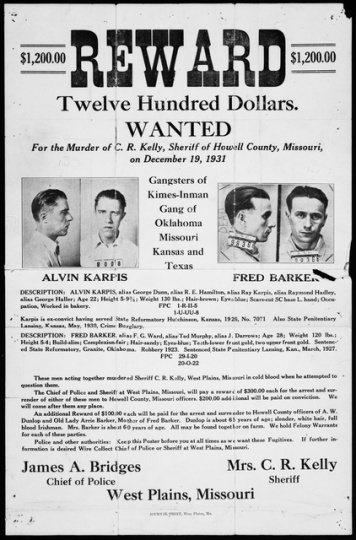
Reward poster for Alvin Karpis and Fred Barker
Reward poster seeking Karpis and Barker for the 1931 murder of Sheriff C. R. Kelly, the crime that drove the gang from Missouri to St. Paul.
Holding Location
Articles
More Information
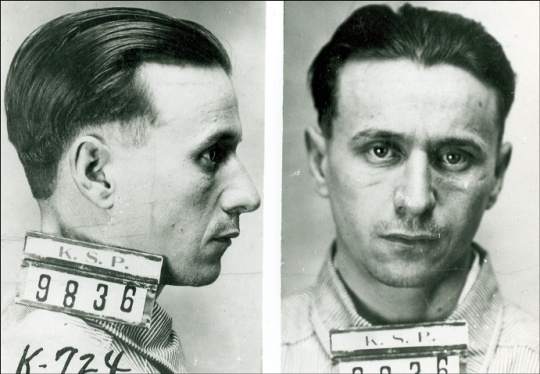
Fred Barker
Fred Barker when he entered the Kansas State Penitentiary, where met Alvin Karpis. Photograph by the Federal Bureau of Investigation, 1930.
Public domain
Holding Location
Articles
More Information
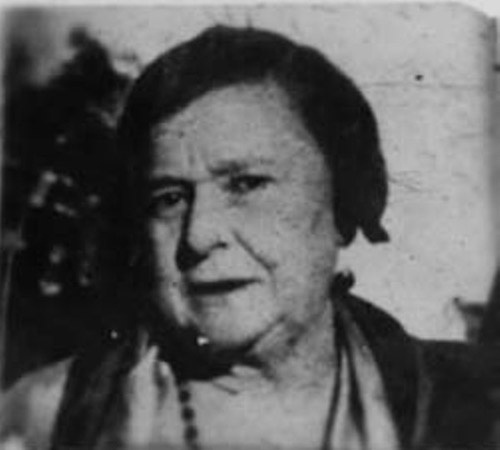
Kate “Ma” Barker
Kate Barker, 1931. More commonly known as Arizona, Arrie, or Ma Barker, she accompanied her sons throughout their criminal years in the Barker‒Karpis gang.
Por 16552 r1 (Locator Number SV)
Holding Location
Articles
More Information

Fred Barker
Fred Barker in 1931.
Holding Location
Articles
More Information

W.W. Dunn with William Hamm Jr.
The gang’s ransom contact, W. W. Dunn, standing with William Hamm Jr. in 1933.
Holding Location
Articles
More Information

Edward George Bremer
Edward Bremer in 1934.
Holding Location
Articles
More Information
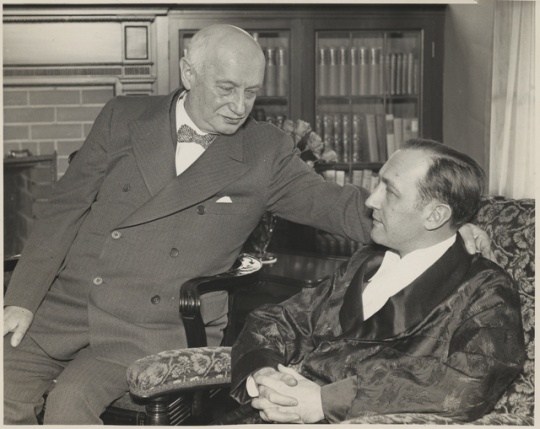
Adolph Bremer with Edward Bremer, his son
Adolph Bremer with his son after his 1934 kidnapping and return.
Por 15388 p1 (Locator Number SV)
Holding Location
Articles
More Information
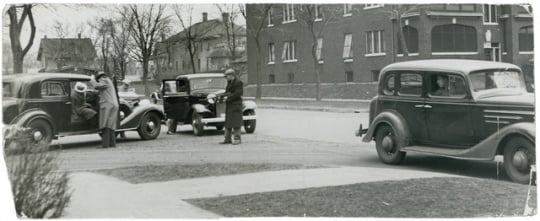
Scene of the Bremer kidnapping
The corner of Lexington and Goodrich Avenues in St. Paul, where Bremer was kidnapped in 1934.
Holding Location
Articles
More Information
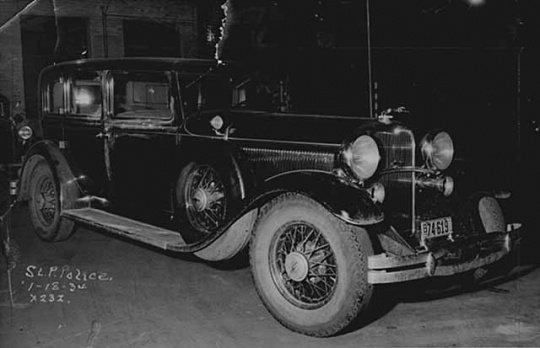
Edward G. Bremer’s 1932 Lincoln sedan
The car Bremer was driving when he was kidnapped by the Barker‒Karpis gang in 1934.
Holding Location
Articles
More Information
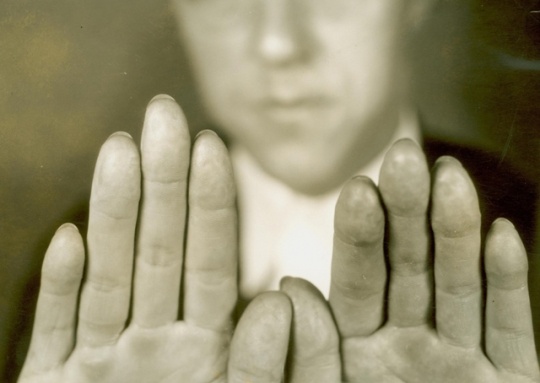
Removed fingerprints
Alvin Karpis shows his altered fingertips, 1934. Karpis had his fingerprints removed by underworld physician Joseph Moran after the Bremer kidnapping.
Public domain
Holding Location
Articles
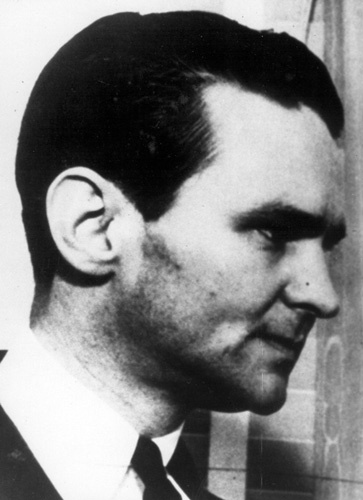
FBI Agent Melvin Purvis
Purvis led the FBI’s investigation of the Hamm and Bremer kidnappings. Photograph by the Federal Bureau of Investigation, date unknown.
Public domain
Holding Location
Articles
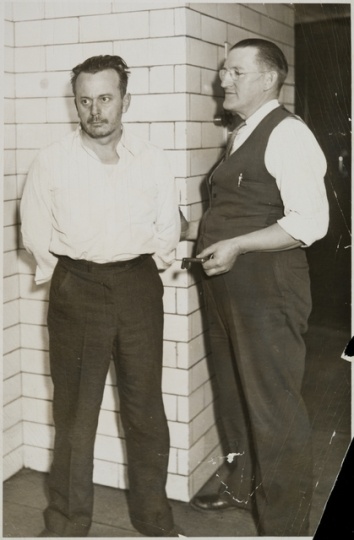
Arthur “Doc” Barker, left, with jailer, William Gates
Doc Barker, a suspect in the Edward Bremer kidnapping. Photograph by the Saint Paul Daily News, 1935.
HV8.2 p24
Holding Location
Articles
More Information
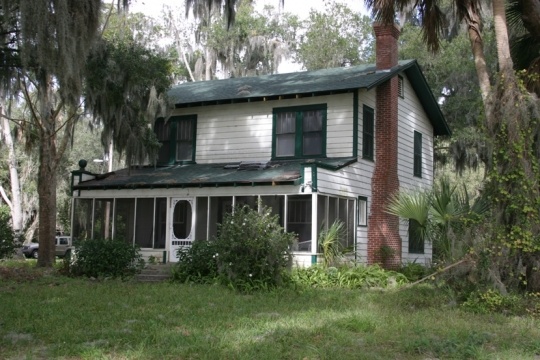
The Barker cottage on Lake Weir
Fred and Ma Barker used this cottage as their Florida hideout. Here, FBI officers engaged in the shootout that killed both Fred and Ma.
Public domain
Holding Location
Articles
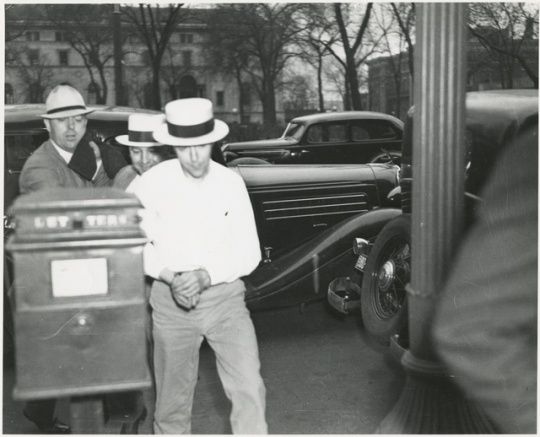
Alvin Karpis in St. Paul
A captured Alvin Karpis is brought to St. Paul on May 3, 1936, in connection with the Hamm and Bremer kidnappings.
Public domain
Holding Location
Articles
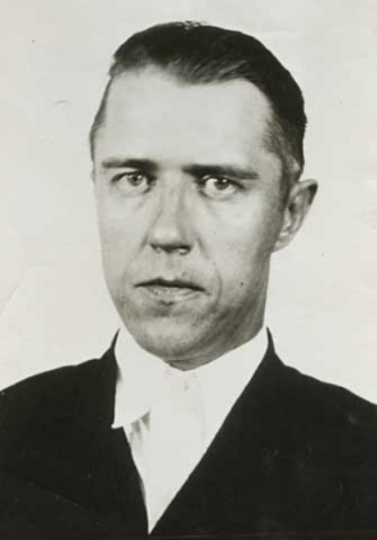
Alvin “Creepy” Karpis in 1936.
Alvin “Creepy” Karpis in 1936.
Holding Location
Articles

Alcatraz Penitentiary
Alvin Karpis and Doc Barker served time on Alcatraz in the Bay of San Francisco. Karpis became the penitentiary’s longest serving inmate.
Articles
More Information
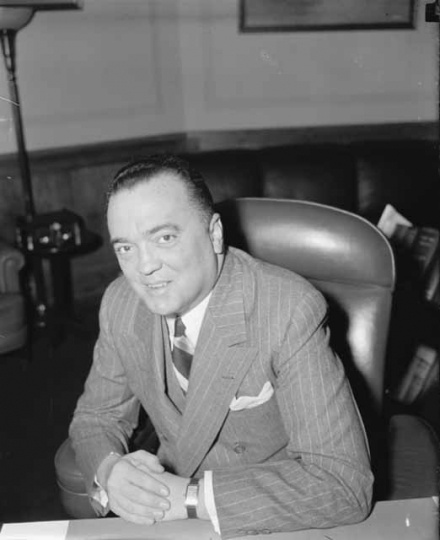
J. Edgar Hoover
J. Edgar Hoover, director of the FBI during Hamm and Bremer kidnappings, in 1940. Hoover guided the FBI’s attempts to rid the US of “public enemies” like the Barker‒Karpis gang.
Public domain
Holding Location
Articles
More Information
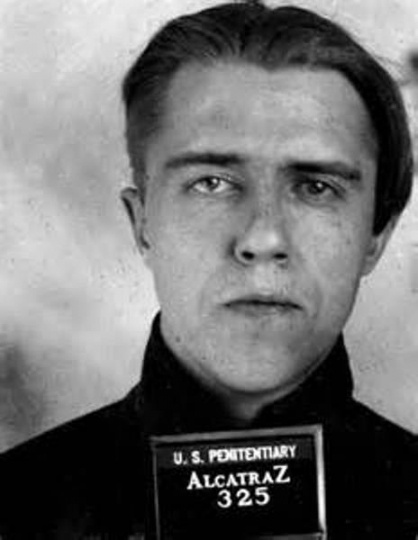
Alvin Karpis
Alvin Karpis when he entered the federal prison on Alcatraz Island, ca. 1936.
Public domain
Holding Location
Articles
Related Articles
Turning Point
The gang kidnaps Edward Bremer, whose family has connections to President Franklin D. Roosevelt. Roosevelt pressures the FBI to find Bremer’s kidnappers and Bremer’s family delays ransom payment. Both factors contributed to the gang’s downfall.
Chronology
1930
1931
1932
1932
1932
1933
1933
1933
1933
1934
1934
1935
1936
1935-36
Bibliography
Federal Bureau of Investigation. The Kidnapping of Edward George Bremer, St. Paul, Minnesota: History and Early Association of the Karpis-Barker Gang Prior to the Abduction of Mr. Bremer, by Federal Bureau of Investigation, I.C. #7-576, Washington, DC: FBI, 1936. https://vault.fbi.gov/barker-karpis-gang/bremer-investigation-summary/Barker-Karpis%20Gang%20Summary%20Part%201%20of%201/view
History Channel. Ma Barker: Crime Family Values. YouTube, 2017.
https://www.youtube.com/watch?v=lCpA_Im5JQY
Maccabee, Paul. John Dillinger Slept Here: A Crooks’ Tour of Crime and Corruption in St. Paul, 1920‒1936. St. Paul: Minnesota Historical Society Press, 1995.
Mahoney, Timothy. Secret Partners: Big Tom Brown and the Barker Gang. St. Paul: Minnesota Historical Society Press, 2013.
USP Alcatraz. "Alcatraz Convict - Alvin Karpis (AZ-325), Public Enemy #1." YouTube, 2017.
https://www.youtube.com/watch?v=ieeHO7uXsZs
Related Resources
Secondary
Guthrey, Molly. “Ma Barker Gang’s Old West St. Paul Hideout For Sale.” St. Paul Pioneer Press, May 27, 2013.
https://www.twincities.com/2017/05/27/depression-era-gangsters-lair-for-sale-in-west-st-paul/
St. Paul gangster history research collection, 1981‒1995
Manuscripts Collection, Minnesota Historical Society, St. Paul
Description: Research and interview notes; correspondence; photocopies of newspaper and magazine articles and book excerpts; photocopies of FBI, St. Paul Police Department, and Minnesota Bureau of Criminal Apprehension investigation records; photocopies of federal and state prison inmate and court records; and photocopies of birth and death certificates, all created or compiled by Maccabee for his book John Dillinger Slept Here.
http://www2.mnhs.org/library/findaids/00239.xml
M504
Clippings Relating to the Lindbergh Baby Kidnapping, 1932‒1935
Microfilm collection, Minnesota Historical Society, St. Paul
Description: Newspaper clippings pertaining almost entirely to the kidnapping of Charles A. Lindbergh, Jr., the search for the child, the subsequent investigation, and the trial of Bruno R. Hauptmann for his murder. Most are from St. Paul newspapers.
Reserve 20; Reserve 79
Criminal history files, 1928‒1982 (bulk 1928‒1955)
Minnesota Bureau of Criminal Apprehension
State Archives collection, Minnesota Historical Society, St. Paul
Description: Fifty-one criminal history files, mainly documenting high-profile 1930s gangsters, including Arthur (Doc) Barker, Fred Barker, and Alvin Karpis. Access to and use of these reserve materials requires the permission of State Archives staff.



















